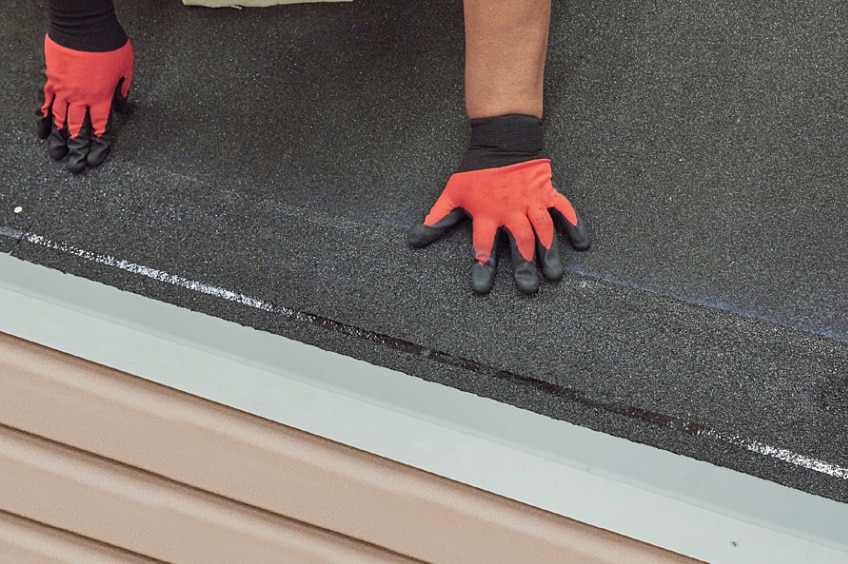If you’re considering a roof replacement or reviewing scopes for a roofing project, you might come across the term “starter strip.” Whether you’re a DIY homeowner, an aspiring handyman or roofer, a roofing sales rep, or even an adjuster, understanding the role of starter strips in an asphalt roofing system is crucial. Let’s dive into what exactly a starter strip is, why it’s important, and some common issues around its use and treatment in insurance claims.
What is a Starter Strip?
A starter strip is an essential component of an asphalt shingle roofing system. It’s specifically designed to be installed along the eaves and rakes of the roof as the first course before the main shingles are applied. This strip ensures proper alignment, provides extra protection against wind and water, and enhances the durability of the roof’s edges. The starter strip acts as a foundation, helping the first row of shingles adhere correctly and shielding the edges from lifting in high winds If you have ever noticed a home with severe shingle loss near the gutters, it is likely that you have seen a lack of starter strip or the result of improper material being used as a starter strip. This product is pivotal to securing the edge of the roof, as the edge is the most susceptible to wind damage.
Why You Shouldn’t Use Alternative Products as a Starter Strip
Some contractors, in an effort to cut costs, manipulate regular shingles or other materials to imitate a starter strip. While this may seem like a minor shortcut, it’s far from ideal. Starter strips are uniquely designed with a glue line on the underside, which adheres to the first course of shingles to hold them securely in place, particularly in areas prone to wind. Standard 3-tab shingles (most commonly used as starter alternatives) have a sealant strip across the middle of the shingle. To manipulate this shingle to act as a starter course, you are relying on the contractor to manually cut the shingles near the middle, allowing for enough shingle to remain under the first row, while also appropriately securing the very edge. Starter strips are factor cut and sized to be the perfect fit for your system in every instance.
Using alternative products like cutting regular shingles may save some money upfront, but it leads to significant risks:
- Manufacturer Specifications: Starter strips are created to meet specific design and installation guidelines. Improperly using cut shingles or other materials could void the manufacturer’s warranty. This means if something goes wrong down the road, you’re on your own for repairs or replacements.
- Design Issues: Regular shingles don’t have the same adhesive properties or structural design as starter strips. Without the proper glue line, the edges of your roof can become vulnerable to wind damage, water intrusion, and potential leaks. Over time, this can lead to costly repairs that could have been avoided.
- Long-Term Durability: Proper starter strips are designed to increase the roof’s durability and wind resistance. Manipulating other materials to act as a starter strip compromises the roof’s overall strength and longevity, leaving it more susceptible to damage during storms or severe weather. This can potentially equate to the need to replace the roof system prior to its anticipated replacement age.
Starter Strip in Insurance Claims
Due to so many contractors not using starter strip and/or manipulating other products as an alternative, starter strips often come up during insurance claims for roof replacements. Unfortunately, some insurance carriers may try to include the starter strip within the shingle waste factor. Meaning they expect contractors to use the standard allowance for cut shingles to find pieces the contractor deems suitable for re-use as starter strip.
This is problematic because a starter strip isn’t just extra material or leftover waste; it’s a separate product with its own function and price point.
Here’s why it’s important to separate starter strips from shingle waste:
- Specific Function: As mentioned, starter strips have a distinct role in a roofing system. They can’t be lumped into general waste because they provide the necessary adhesion and wind resistance at the roof’s edge. By accounting for this product in the waste factor, the homeowner is
A.) Being shorted on the actual shingle coverage needed for the roof.
B.) Likely being required to use improper products that void their roof manufacturer’s warranty.
- Material Cost: Starter strips are priced separately from shingles, and including them in a waste factor often results in underpaying for the necessary materials. Homeowners and contractors should ensure that starter strips are accounted for as their own line item during insurance claims, preventing underfunding for proper installation.
- Proper Coverage: When filing an insurance claim, it’s important to verify that your adjuster understands the role and cost of starter strips. Failure to do so could lead to an improperly paid claim and potential issues with the roof’s longevity if contractors are forced (or willing) to cut corners.
Conclusion
Understanding what a starter strip is and why it’s important can help you make better decisions during a roof replacement. Whether you’re a homeowner, aspiring roofer, sales rep, or adjuster, knowing that starter strips serve a vital purpose in your roof’s overall design and wind resistance will help you avoid costly mistakes. Always ensure the use of proper starter strips and advocate for their inclusion as a distinct line item in insurance claims. Taking these steps will help you maintain the integrity of your roofing system and avoid unnecessary future repairs.


Simply desire to say your article is as surprising The clearness in your post is simply excellent and i could assume you are an expert on this subject Fine with your permission let me to grab your feed to keep up to date with forthcoming post Thanks a million and please carry on the gratifying work